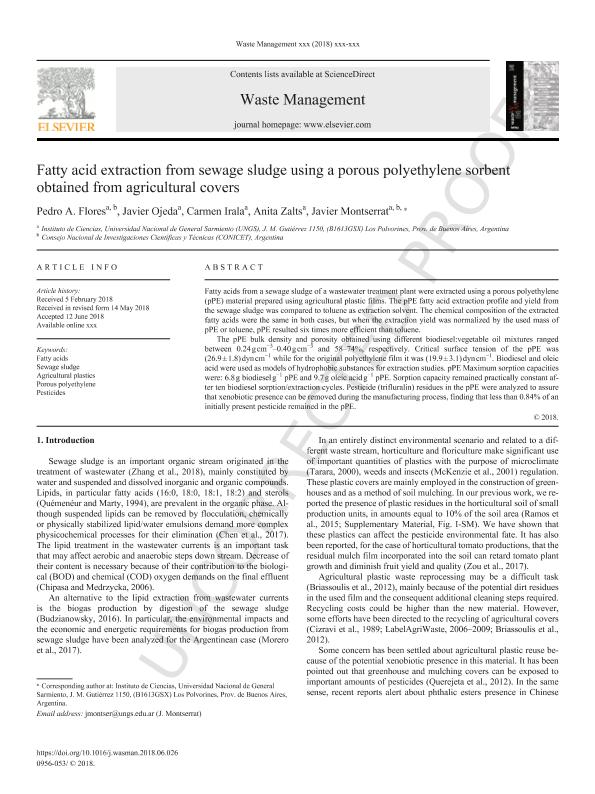Artículo
Fatty acid extraction from sewage sludge using a porous polyethylene sorbent obtained from agricultural covers
Fecha de publicación:
08/2018
Editorial:
Pergamon-Elsevier Science Ltd
Revista:
Waste Management (elmsford)
ISSN:
0956-053X
Idioma:
Inglés
Tipo de recurso:
Artículo publicado
Clasificación temática:
Resumen
Fatty acids from a sewage sludge of a wastewater treatment plant were extracted using a porous polyethylene (pPE) material prepared using agricultural plastic films. The pPE fatty acid extraction profile and yield from the sewage sludge was compared to toluene as extraction solvent. The chemical composition of the extracted fatty acids were the same in both cases, but when the extraction yield was normalized by the used mass of pPE or toluene, pPE resulted six times more efficient than toluene. The pPE bulk density and porosity obtained using different biodiesel:vegetable oil mixtures ranged between 0.24 g cm−3–0.40 g cm−3 and 58–74%, respectively. Critical surface tension of the pPE was (26.9 ± 1.8) dyn cm−1 while for the original polyethylene film it was (19.9 ± 3.1) dyn cm−1. Biodiesel and oleic acid were used as models of hydrophobic substances for extraction studies. pPE Maximum sorption capacities were: 6.8 g biodiesel g−1 pPE and 9.7 g oleic acid g−1 pPE. Sorption capacity remained practically constant after ten biodiesel sorption/extraction cycles. Pesticide (trifluralin) residues in the pPE were analyzed to assure that xenobiotic presence can be removed during the manufacturing process, finding that less than 0.84% of an initially present pesticide remained in the pPE.
Archivos asociados
Licencia
Identificadores
Colecciones
Articulos(SEDE CENTRAL)
Articulos de SEDE CENTRAL
Articulos de SEDE CENTRAL
Citación
Flores, Pedro Agustín; Ojeda, Javier; Irala, Carmen; Zalts, Anita; Montserrat, Javier Marcelo; Fatty acid extraction from sewage sludge using a porous polyethylene sorbent obtained from agricultural covers; Pergamon-Elsevier Science Ltd; Waste Management (elmsford); 78; 8-2018; 532-540
Compartir
Altmétricas




